That is in all probability essentially the most difficult second in historical past for making meals selections. In spite of everything, Paleolithic diners merely roasted mammoth steaks over a hearth and served them with a facet of nuts and berries. It isn’t like that they had to decide on whether or not to drink low-fat or entire milk, or which of the 200 completely different sorts of packaged potato chips they’d dive into.
Throughout a visit to most native markets, buyers are confronted with greater than 43,000 objects [source: Food Marketing Institute]. Simply how, precisely, do we all know which meals to decide on? For many people, the choice to achieve for fat-free cookies as an alternative of the full-butter model looks as if an instinctual one. Fueled by information reviews, useful ideas in shiny magazines and the occasional weblog, we all know to keep away from fats, excessive fructose corn syrup, skin-on rooster and extra. However what if most of what we learn is incorrect?
From salt to sugar, we have investigated 10 broadly held vitamin "details" which have little actual worth and can share the reality with you. We’ll begin with the dieter’s finest buddy, the low-fat meals merchandise.
Contents
- Fats-free Meals are Higher for Dieters
- A Potato's Vitamins Are All within the Pores and skin
- Excessive Fructose Corn Syrup Is Worse Than Sugar
- Eat Carrots for Higher Imaginative and prescient
- Sea Salt Is More healthy Than Common Salt
- Fiber, in Any Kind, Is Good for You
- All the time Take away the Pores and skin From Rooster
- Keep away from Entire Milk Due to the Fats
- A Gluten-free Eating regimen Can Assist Anybody
- Meals Cravings Imply You Lack Particular Vitamins
10: Fats-free Meals are Higher for Dieters
“
Wendy Maeda/The Boston Globe through Getty Photos
Should you’re watching your waistline, likelihood is you have stocked up on just a few helpers: fat-free salad dressing, "lite" mayonnaise and low-fat cookies. Sadly, as you munch your manner by way of that field of not-very-tasty fat-free mini-muffins, there are lingering doubts. If a lot of what you eat is low-fat or fat-free, why aren’t you losing a few pounds?
It is as a result of fat-free meals have a darkish facet. They might lower out the fats, but it surely’s been changed with sugar — numerous sugar, which helps make fat-free meals extra palatable. This is not a greater choice as a result of sugar is saved within the physique as fats [sources: Glassman, Poulter].
Mistakenly believing low-fat meals — outlined as having lower than 3 grams of fats per serving — save energy can even result in extra consumption of the product reasonably than consuming the full-fat model. In actual fact, some low-fat meals have nearly as many (or extra) energy and sugar because the common model. Plus the sodium is commonly greater. As an example, the Dunkin’ Donuts blueberry muffin has 460 energy, 44 grams of sugar and 450 grams of sodium. The decreased fats model has 410 energy, 40 grams of sugar and 620 grams of sodium [sources: WebMD, Dunkin’ Donuts].
9: A Potato's Vitamins Are All within the Pores and skin
“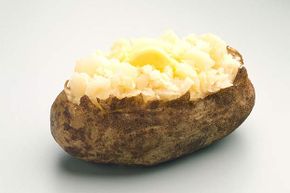
Jupiterimages/Pictures.com/Thinkstock
A few of us don’t love potato skins, however we nonetheless hear our moms’ voice after we depart it on the plate: "A potato’s vitamins are all within the pores and skin." Whereas there’s some foundation to the assertion — potato pores and skin is wealthy in fiber and different vitamins — that is not the entire story [source: Academy of Nutrition and Dietetics].
Reality is, solely about 20 p.c of the potato’s vitamin is discovered on the pores and skin [source: U.S. Potato Board]. The pores and skin of a medium potato comprises 920 milligrams of potassium and three.6 grams of fiber, whereas the flesh (with out the pores and skin) nonetheless presents 676 milligrams of potassium (greater than a banana) and a pair of.6 grams of fiber [source: Flipse]. Not too unhealthy, proper?
Plus, the flesh of the potato comprises nutritional vitamins C, Ok and B6, in addition to a wholesome dose of niacin and thiamin. A medium potato’s flesh additionally has magnesium, phosphorus, copper, manganese, zinc, riboflavin and folate — all for lower than 150 energy [source: Self].
8: Excessive Fructose Corn Syrup Is Worse Than Sugar
“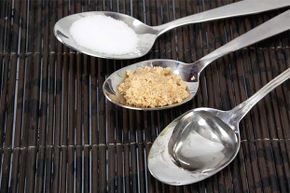
Robert Pears/E+/Thinkstock
As meals villains go, excessive fructose corn syrup (HFCS) is close to the highest of the checklist. It debuted within the Seventies and have become the darling of the meals and beverage business as a result of it tasted just like sugar, however was extra secure throughout meals processing.
Nonetheless, as its prominence has grown – HFCS reveals up in sodas, bread and condiments, amongst an enormous array of merchandise – so has the scale of American waistbands [source: Hendley]. Coincidence or wrongdoer?
The jury remains to be out. Chemically, HFCS is similar to sucrose (desk sugar). Whereas sugar contains equal quantities of fructose and glucose, HFCS is 55 p.c fructose and 42 p.c glucose. An extra 3 p.c of bigger sugar molecules, referred to as greater saccharides, make up the remaining. Each sucrose and HFCS have the identical variety of energy. Consuming an extra of both sweetener can result in weight achieve, fatty liver illness, insulin resistance, coronary heart illness and Kind 2 diabetes [sources: Parker, Hendley].
Nonetheless, there does appear to be a distinction in the best way HFCS (made out of corn) and sucrose (made out of beets and cane) are metabolized. In research of rats fed a gradual food plan of HFCS, the rodents gained much more weight and stomach fats than the rats that had been fed sucrose. Researchers do not but perceive why the HFCS-fed rats had been extra susceptible to weight problems. One speculation is that the surplus fructose was metabolized to supply fats, whereas the glucose was both processed for power or saved as a carbohydrate within the liver and muscle mass [source: Parker].
7: Eat Carrots for Higher Imaginative and prescient
“
yungshu chao/iStock/Thinkstock
Thousands and thousands of youngsters have been inspired to crunch carrots for the sake of their eyesight. However these guarantees of higher imaginative and prescient, together with the flexibility to see at midnight, exist primarily due to a wartime propaganda marketing campaign.
Throughout World Battle II, the British authorities attributed the flexibility of its night-flying pilots to shoot down Nazi bombers to their carrot consumption. In actuality, the pilots had been using a brand new sort of radar. Though it was a ruse to throw Germans off monitor, the thought caught on. Even British civilians started consuming extra carrots with a purpose to higher discover their manner round throughout blackouts, and likewise planted them in "victory gardens" [source: Smith].
The parable of vision-improving carrots leapt continents and many years, and stays highly effective immediately. Whereas it is true that carrots are good for sustaining imaginative and prescient, they do not provide visible superpowers, like seeing at midnight. Nonetheless, carrots are excessive in beta carotene, a part in vitamin A, which is crucial for imaginative and prescient. In actual fact, if an individual has a vitamin A deficiency, correcting it could enhance poor evening imaginative and prescient [source: O’Connor].
6: Sea Salt Is More healthy Than Common Salt
“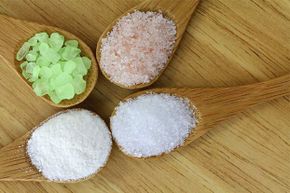
sasimoto/iStock/Thinkstock
Whether or not it is black, pink, grey or purple, sea salt definitely stands out, in taste, coloration and texture. The irregularly formed rocks are gleaned from the ocean as water evaporates. The result’s a rough, unprocessed salt laced with hint ranges of minerals, corresponding to calcium, magnesium, potassium.
Desk salt, alternatively, is harvested from underground salt deposits after which processed to reach at its positive and uniform texture. As a result of all minerals have been stripped away and components have been included to stop clumping, that is the much less healthful alternative, proper?
Seems, sea salt is not any higher for you than desk salt, and each ought to be utilized in moderation. Sea salt and desk salt have the identical sodium content material, which is about 575 milligrams of sodium per quarter teaspoon (the American Coronary heart Affiliation recommends ingesting not more than 1,500 milligrams a day). Each varieties of salt put you equally in danger for creating hypertension, which in flip raises the incidence of coronary heart illness.
However what in regards to the hint quantities of minerals present in sea salt? They do not actually provide you with a dietary benefit as a result of they’re simply present in different widespread meals, like nuts, legumes, dairy and a few fruit and veggies, like oranges and leafy greens [source: Kannall].
And the iodine added to desk salt to assist forestall goiters attributable to iodine deficiency? It is also present in the whole lot from fish and dairy merchandise to soy sauce and eggs [sources: American Heart Association, American Thyroid Association].
5: Fiber, in Any Kind, Is Good for You
“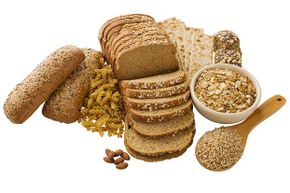
Tetra Photos/Thinkstock
Fiber is discovered naturally in most of the meals we eat, like fruit and veggies, entire grains and legumes. Naturally occurring fiber prevents constipation, lowers the danger of diabetes and coronary heart illness, and even helps preserve our weight [source: Mayo Clinic].
Grocery retailer cabinets are crammed with meals which have surprising additions of fiber, like yogurt, ice cream, sugary cereals and even water. Sadly, these fiber-added meals do not provide the identical advantages as meals which can be naturally excessive in fiber.
That is as a result of entire meals like oatmeal include advanced fiber, however fiber-enriched meals like white bread depend on a single sort of fiber. These remoted fibers are both chemically synthesized or extracted from fiber-rich vegetation. Whereas remoted fibers do have some advantages, like serving to you’re feeling full, there are sometimes too few in a single serving to make a lot of a distinction to your well being. As well as, remoted fibers aren’t environment friendly at encouraging bowel actions, and have little affect on blood sugar or ldl cholesterol. Consumed in giant quantities, they will trigger fuel and bloating [source: Berkeley Wellness].
In the long run, we’re higher off consuming meals which can be naturally fiber-rich as a result of they include a wide range of fibers with clear well being advantages. A bagel made with refined flour, that has been fortified with the chemically synthesized fiber, simply is not nearly as good for the physique as the entire grain model [source: Berkeley Wellness, Cooking Light].
4: All the time Take away the Pores and skin From Rooster
“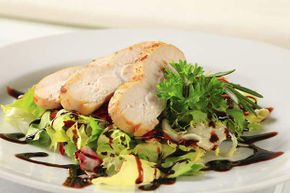
vikif/iStock/Thinkstock
Behold the skinless rooster breast. A dieter’s staple, this bland and dry lower of meat has been showing atop salads and subsequent to haricot verts for years. Is not it time to take a better have a look at why we’re consuming it?
If ideas of roast rooster with crispy, flavorful pores and skin overlaying a moist and equally savory lower of meat are dancing by way of your head, take note of them. Pores and skin-on rooster is not as unhealthy as we as soon as thought. A 12-ounce (340-gram) bone-in rooster breast with pores and skin intact may have a further 50 energy and a pair of.5 grams of saturated fats greater than its boneless, skinless, tasteless counterpart. Plus, 55 p.c of the fats in rooster pores and skin is heart-friendly monounsaturated fats [source: Cooking Light]. So be at liberty to indulge from time to time.
In actual fact, the bone and pores and skin play essential roles in the course of the cooking course of. The bone will assist evenly distribute warmth because the rooster cooks, whereas the pores and skin will maintain the outside from drying out earlier than the inside is totally cooked [source: Royer]. So, you will get a greater taste in case you cook dinner the rooster with the pores and skin on after which take away it earlier than serving.
3: Keep away from Entire Milk Due to the Fats
“
© Ruaridh Stewart/ZUMA Press/Corbis
You have in all probability heard the Dietary Tips for People’ suggestion to restrict saturated fats to lower than 10 p.c of your each day caloric consumption. For a lot of, this has meant chopping again on cheese, ice cream and butter, and switching from entire milk to skim milk (a watery, much less flavorful model of entire milk) [source: CDC].
Avoiding fat in dairy was speculated to translate into more healthy hearts and slimmer waistlines. The concept saturated fats elevated the danger of heart problems grew to become well-liked within the Fifties. (One cup of entire milk has 4.6 grams of saturated fats, 22 p.c of the present Advisable Day by day Allowance.) Nonetheless, rising analysis finds dairy fats is not unhealthy for our hearts or our weight. As counterintuitive because it appears, the alternative might be true. Consuming full-fat entire milk has been linked to a decreased threat of heart problems and Kind 2 diabetes, in addition to decrease blood stress [sources: Giles-Smith, Teicholz].
Entire milk appears to battle weight problems, too. A research revealed within the "Scandinavian Journal of Major Well being Care" discovered that if full-fat milk, butter and cream had been a part of the diets of middle-aged males, they had been far much less prone to turn into overweight over a 12-year interval in contrast with males who did not devour high-fat dairy. A meta-analysis of 16 research, revealed within the "European Journal of Diet," reported the consumption of high-fat dairy was linked to a decrease threat of weight problems. Related findings have been reported for kids [source: Aubrey].
The advantages lie in entire milk’s advanced and useful fat, which embody greater than 400 completely different fatty acids combined in a healthful milieu of protein, calcium and different vitamins. As well as, scientists suspect entire milk could include a yet-unnamed substance that alters the metabolism to burn fats for power, as an alternative of storing it [sources: Giles-Smith, Teicholz].
2: A Gluten-free Eating regimen Can Assist Anybody
“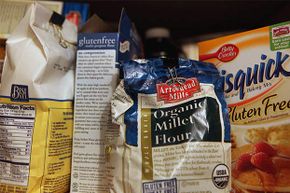
Wendy Maeda/The Boston Globe through Getty Picture
Know somebody consuming gluten-free? This food plan, supposed for these with celiac illness and gluten intolerance, is becomingly more and more widespread — even for many who do not essentially want it. However,
there’s little proof to help the concept that going gluten-free is healthier for the overall inhabitants.
Folks with celiac illness are unable to digest gluten, a protein present in wheat, rye and barley. In the event that they eat gluten, over time it damages the small gut and makes it tough to soak up vitamins. Gluten intolerance is marked by fatigue and belly misery. Switching to a gluten-free food plan can carry a metamorphosis; immediately, individuals with celiac illness or gluten intolerance really feel higher and have extra power. However except you could have the identical situation, making the swap will not provide the similar outcomes [source: Hendley].
1: Meals Cravings Imply You Lack Particular Vitamins
“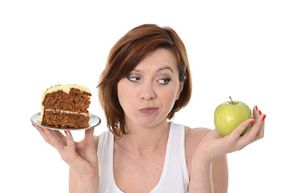
OcusFocus/iStock/Thinkstock
Cannot get sufficient chocolate? Is cheese your kryptonite? Unable to withstand purple meat? Then your physique have to be craving particular vitamins present in these meals.
Sadly, it is a longstanding meals fable. The concept your physique, at an elemental degree, is sending indicators to your mind forcing you to drink a glass of orange juice or dive right into a slice of cheesecake is solely off the mark.
Meals cravings, a minimum of for people, are likely to revolve round emotional wants reasonably than bodily ones. In actual fact, if a meals is forbidden (do not forget that slice of cheesecake?), you will in all probability need it all of the extra. There’s one notable exception: If you’re nutritionally poor in iron, you will have cravings — however not for iron-rich steak or liver, as you may think. As a substitute, you may chew on important quantities of ice cubes, a situation referred to as pagophagia. It is a variant of pica, a dysfunction wherein individuals eat issues — clay, paper, chalk — that are not truly meals [source: O’Connor, Weil].







